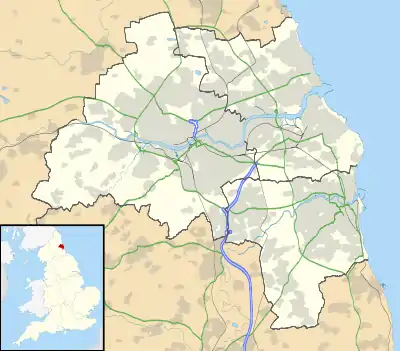West Moor
West Moor (also sometimes written as "Westmoor") is a small place in Tyne and Wear, UK.
West Moor began as a colliery village around the beginning of the 19th century. It was so-called because it lies to the west of the ancient Killingworth Moor, which has now disappeared under development. It was at the colliery here in 1804 that George Stephenson started work as a brakeman. Rather than a village, West Moor might nowadays best be described as a suburb of Newcastle upon Tyne; it is close to Killingworth, Forest Hall, Longbenton and Gosforth Park.
West Moor contains a primary school – its middle school was closed down in 2000 – several shops and a pub, the George Stephenson Inn. Trains on the East Coast Main Line run through West Moor over a railway bridge.
Places of interest
George Stephenson's Dial Cottage
George Stephenson became an assistant to his father and later followed in his footsteps to become the engineman at Killingworth colliery. It was there that Stephenson developed one of the earliest locomotives, called the Blücher, which ran on the Killingworth colliery railway in 1814. It was capable of pulling 30 tons up a grade at 4 miles per hour. He also convinced the mine manager to experiment with steam locomotion, and over the next several years Stephenson had built a further 16 engines at Killingworth.
While developing the Blücher, Stephenson lived in "Dial Cottage", which still stands on the Great Lime Road in West Moor, south of Killingworth. When George moved in the cottage consisted of one room and a garret reached by a ladder. By the time he left he had extended and converted the premises to become a comfortable four-roomed house.[1] The cottage has a sundial, made by Stephenson himself, and a plaque above the door which reads
George Stephenson engineer. Inventor of the Locomotive Engine lived in this cottage from (1805 to 1823), his first locomotive (Blücher) was built at the adjacent colliery wagon shops, and on July 25th 1814 was placed on the wagonway which crosses the road at the east end of this cottage.
 Dial Cottage, 7 May 2006
Dial Cottage, 7 May 2006 Sundial and plaque, 7 May 2006
Sundial and plaque, 7 May 2006

